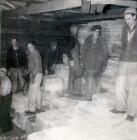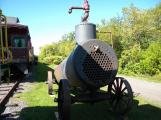14
Inside the ice house20th century
The Tatamagouche Creamery, Creamery Road, Tatamagouche, Nova Scotia, Canada
 Credits:
Credits:North Shore Archives
Willis Cock
15
As much ice was packed into the icehouse as possible because the supply had to last until the next winter. Summers were hot, so the ice was covered in several inches of sawdust to keep it insulated. Packing the ice closely together in the icehouse also helped keep it from melting.16
Hot water and steam were also essential to the Creamery. Steam from a boiler was used to heat and pasturize the cream as well as clean the cream cans and other equipment and utensils. It also served to heat the building with two hot water heaters with fans on the main floor and one on the second floor.Also, originally the equipment in the creamery was driven by a steam engine through a line shaft and various belts linked to the individual pieces of equipment. Later, the equipent was electrically driven.
17
Creamery boiler20th century
The Tatamagouche Creamery, Creamery Road, Tatamagouche, Nova Scotia, Canada
 Credits:
Credits:North Shore Archives
18
This large boiler was used to provide steam and hot water. It was manufactured in New Glasgow, Nova Scotia and was fired by coal mined in Nova Scotia that was delivered by rail to the Creamery, though it was later converted to oil.When this boiler was shut down to be cleaned or repaired a portable steam boiler was used during the interim. It was made at the New Glasgow Foundry in Pictou County, Nova Scotia, and currently is located at the Train Station Inn in Tatamagouche, close by the Creamery.
20
So much water was used in the cleaning and processing operation of the Creamery that drainage and venting was very important. An underfloor drainage system was used on the main level to catch waste water. Also, the steam used in butter making generated a great deal of moisture and the upstairs of the Creamery was ventilated with grills at the base of walls that drew moist air to the roof peak where it was vented outside.21
Vents in the Creamery walls to allow moisture to escape20th century
The Tatamagouche Creamery, Creamery Road, Tatamagouche, Nova Scotia, Canada
 Credits:
Credits:Creamery Sqaure Hertiage Centre
